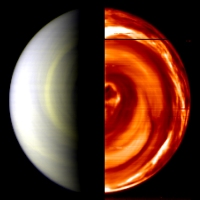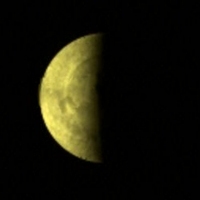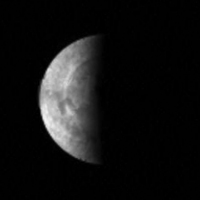No. 23 - Successful Orbit Insertion
All operations leading to the burn and immediately after have been nominal both on the space and the ground segments.
Only 48 hours after the successful Venus Orbit Insertion (VOI) the first science data have been received on ground showing astonishing pictures of the planet. The spacecraft is now in a 9-day orbit during which 6 science observations are planned together with a Pericenter Control Manoeuvre and the first Apocenter Lowering Manoeuvre.
The table below shows a chronology of the main activities in the reporting period:
| MET (Day) | Date | DOY | Main Activity |
| 150 | 07/04/06 | 097 | VOI Commands Uplink |
| 151 | 08/04/06 | 098 | SC monitoring |
| 152 | 09/04/06 | 099 | SC monitoring |
| 153 | 10/04/06 | 100 | FDIR Run-down and SSMM Switch OFF |
| 154 | 11/04/06 | 101 | VOI Operations |
| 155 | 12/04/06 | 102 | Swap to HGA1 and 1st science observation (COB00) |
| 156 | 13/04/06 | 103 | 2nd Science observation (COB01) |
At the end of the last Cebreros pass in the reporting period (DOY 103, 13:00) Venus Express was orbiting Venus at 124 million km from the Earth and 108.6 million km from the Sun. The one-way signal travel time was 413 seconds.
Spacecraft Status
AOCS
The Main Engine has been successfully fired on DoY 101 for the capture burn. The commanded delta-V was 1251 m s-1.
Payload Activities
ASPERA
The instrument has been successfully operated as part of the COB01 observation.
MAG
The instrument has been switched ON on DoY 102 as part of the science operations for the capture orbit.
PFS
The instrument is OFF.
SPICAV
The instrument is OFF and will be operated for the next science observations during the capture orbit.
VeRA
The USO is kept powered but muted.
VIRTIS
The instrument has been operated on DoY 102 and 103 as part of the capture orbit operations. The quality of the data is judged very good. The instrument will be operated for all the 6 science observations of the capture orbit.
 |
|
VIRTIS composite image of the Venusian south pole |
This VIRTIS image shows on the left the Sun-illuminated side of Venus at UV wavelengths, visualising streaks due to high speed winds at about 65-70 km altitude. On the right hand side the image shows the thermal radiation from the lower atmosphere penetrating the clouds at a wavelength of 1.7 μm. The structure is due to clouds at a level of 55-60 km where dense clouds block more radiation, resulting in darker colours and thinner clouds resulting in brighter colours. The dynamic structure of this part of the atmosphere is evident. The pixel size is 50 km.
VMC
The instrument has been operated on DoY 102 and 103 as part of the capture orbit operations. The quality of the data is being assessed. The instrument will be operated for all the 6 science observations of the capture orbit.
The VMC image shows the Sun-illuminated side of Venus, as seen from the south pole through a UV filter, both in false colour and greyscale. The pixel size is 150 km.
 |
 |
|
VMC false colour image |
VMC greyscale image |
The first Venus Express data received from the VIRTIS and VMC already shows that this mission will have a major impact on Venus research and Solar System research in general.
Ground Facilities
The Venus Express ground station network for VOI operations included the following stations:
- ESA Cebreros
- ESA New Norcia
- DSN Madrid
- DSN Goldstone
- DSN Canberra
From now onwards Cebreros is the primary station for Venus Express with New Norcia and DSN stations providing support for Radio Science operations.
All ground segment systems performed nominally during the VOI operations.
Orbit Insertion Events
This is the detailed sequence of events as conducted in the 48 hours around the VOI capture burn.
| DoY 100 - 10 April 2006 | |
| 07.00 | Solar Arrays repositioning for capture burn |
| 10:00 | Wake-up timers and HIBs setting |
| 10:45 | SSMM Switch OFF |
| 19:05 | Main Engine Boost Mode parameters setting for VOI burn |
| 20:30 | Last TC (ping) before VOI to reset TLMAP counter |
| DoY 101 - 11 April 2006 | |
| 05:54 | Slew to burn attitude started |
| 06:24 | End of slew to burn attitude - X-TX OFF |
| 07:04:35 | Switch to Main Engine Boost Mode - Burn Init Phase / Watch-dog inhibition |
| 07:07:56 | Liquid Settling Phase started |
| 07:10:29 | Main Engine burn started |
| 07:45 | Occultation start - loss of S-band signal at Madrid |
| 07:55 | Occultation end |
| 07:57 | S-band signal acquisition at Madrid |
| 08:00:28 | Main Engine burn end - Capture confirmed |
| 08:10 | AOCS FDIR partial re-activation |
| 08:45 | DMS FDIR partial re-activation |
| 09:12 | X-band TM reception at Cebreros and Madrid |
| 10:15 | Ephemeredes update |
| 11:30 | AOCS FDIR re-activation |
| 12:00 | Switch to AOCS Normal Mode |
| 12:36 | Switch ON of 4th Reaction Wheel |
| 14:30 | SSMM Switch ON and full configuration |
| 17:00 | TM storage enabled in SSMM |
| DoY 102 - 12 April 2006 | |
| 02:00 | Start slew to invert SC attitude - TTC Reconfiguration to HGA1 |
| 02:30 | End of slew - RF link established via HGA1 |
| 04:00 | USO surveillances enabling |
| 05:40 | Science observations COB00 and COB01 loaded |
The first orbit determination has confirmed excellent performance of the main engine and the following deviations from nominal parameters:
Period: +3.5 hours (~1.6%)
Inclination error: 0.04°
Future Milestones
The spacecraft is now on the 9-day capture orbit which will be lowered with an Apocenter Lowering Manoeuvre of 199.86 m s-1 to be executed in the morning of 20 April. At the apocenter of this orbit (on 15 April) a Pericenter Control Manoeuvre of 5.8 m s-1 will be executed to set the pericenter altitude to the target value of 250 km. Science observations will be performed throughout the capture orbit for a total of 6 observations. The Venus Orbit Commissioning will start on 22 April and payload operations will be interleaved with orbit manoeuvres required to reach the target operational orbit on 7 May.
